Might and Magic X — An Fitting End? Part Two - The Early Games
By ValorianEndymion 2 Comments
Initial Notes:
- Turns that I sort forget about Dark Messiah of Might and Magic, a action based light rpg by Arkane, which is a very good game from what I hear and little I played. The concept of more action game in MM franchise is not new however, as there is Heretics of Might and Magic and Crusaders of Might and Magic, both published by 3DO.
- While I was trying to see if I really missed the screenshots, I did found out some notes of earlier versions of what I planned to write, which might help to speed thing a bit.
- Talking about speeding things up, like I said, I start to write this down in order to finally put it down, after too much time planning and never doing it. Even while I write drafts I noticed that I spend too much time describing stuff and decided to cut it down, since many of the games still high playble and easy to acess and so to avoid spoilers, I will only try to talk the essential, except for earlier games, which are might slight hard to play.
- Like I said before, this part and the next one are sort a recap of the series, I decided to split it to both avoid the text begin two huge and also to give me more time to talk about MM 6 - 9.
I remember, a long time ago, watching the anime “Hai to Gensou no Grimgar” (Grimgar of Fantasy and Ash), which was about a group of strangers that were teleported to a fantasy world, in other words your well known Isekai, but they don’t really remember their previous lives and had to struggle a lot, specially early on.
This initial struggle, where in the first chapters, the protagonists somehow manage to fail to kill a single goblin, until one day they managed to defeat a one, in a very brutal fight. From there they start to speed up, getting better, improving their gear, but also getting themselves in more trouble, that kind stuck with me.
Then I figured out why, it mostly because, either by accident or design, it captures really well how some old crpgs would play sometimes. It reminded me a lot when I first played Might and Magic II: Gates to Another World (1988) and even some other games which I had start playing such as the Wizardry series or the Golden Box titles. Most of what I say next are most toward crpg not so much tabletop.
In some of this games you sort have “three phases”, which I will call “Survival”, “Turning Point” and “Acceleration”.
The first is the Survival, if you play now, either the first Might and Magic or the second game, you might find it very hard — you build a party, start out with minimal resources and each battle could be pretty brutal, in sort its the “early game hell” trope. The reason why, is a combination of elements: first is the obvious one, since you start in these games at level 1 (and many of this games would feature rulet straight from tabletop or at least inspired by), this is the easiest moment to die, the second is the often “random” nature of this game can generate rather deadly situations. During this phase you likely can only take a single combat each time, before you need to rest, therefore the exploration is rather slow.
However sometimes, the Survival phase, can give the game a feeling, specially for dungeon crawlers, of “pushing up your luck” (due the random monsters) and of “risk and reward” (due random rewards), that often fit well with the game themes and atmosphere.
But, the keyword is “phase” because it doesn’t last for long. Or at least isn´t meant to last too much, as it is very trick to get it right without risking producing feeling of either no progress or thing begin too slow.
Note, that the whole survival thing, might don´t work really well in table top, there is a reason why people back in AD&D would skip the first three levels or more.
The second, “Turning Point”, is not much a phase, but a moment, it could be when you reach level 3 or more, at this point, things start to speed up, you can take more combats before each rest and can fight hard enemies, this moment will lead to the Acceleration Phase. As things speed up, you can now take more combats, explore futher before each rest, while rewards increase (but a key factor is for that rewards have to be worth). This continues until the game end. Maybe this was also something that happen by accident, due either monsters list never have something enough to keep up with the player most of the time. Also this might be because sometime older crpg aren´t afraid to give powerful stuff early one, if you know where to look (per example, Eye of the Beholder, had Dagger+4 very well hidden in the first level, I think one of the Ultima games, you had island where if you know the right step you can find powerful loot).
What this all mean? In a curious way, sometimes in older crpg the difficult curve isn´t the way we might expect, but slight backwards, and by this I mean the start can feel harder in the start but as the game follows it get easier. But this does not mean the game will have certain spikes.
Another thing I also which to talk about, is what kind of crpg, MM series even was? I think this is important, because its easy to assume, that all old crpg, “are the same game”, as you often see very different games in tone, thematics, pace and setting often throw in all in the same basket, often in a dimissive way. But what happened is that you have very different lines, paths (and so voices in a certain way), and one thing I hope with this articles is showing the path which the MM series followed and not just nostalgia for it own sake.
With that said, lets begin, for now let´s do a recap of the series:
Might and Magic I — Secret of the Inner Sanctum.

The first and obvious the oldest one in the series, it still a good game, but the age and the limitations of the perido do show. It is easy to forget, but early crpg had to struggle a lot of technical limitations of their period, often entire parts of the plot and even descriptions of items or spell had to either be cut, left in manual or hint book or saved for a next game due stuff such as storage limitations (I mean, this game would come in those old 5 1⁄4 disks, which hold something like 512 kb).
That mean if you which to play it now, be sure to check a faq and the manual, because, you need to check which spells you need to cast, an item description or even some of the really obscure quests which the game featured. You might also need this for the maps, as the game didn´t have an automap.

MM1 was port to a lot of plataforms, such as NES, PC Engine, PC98 and so on, this versions often could be very different, such as the NES/PC Engine/PC 98 which give the game a whole jrpg vibe, with better graphics and even voices! I confess that I really curious about this other versions, do they keep the whole sci fi angle? how Corak and Sheltem look? If you know, please tell!
The main plot is about your character setting out to figure why the good King Alamar, suddenly turn in to a tyrant. But before this you had to create a party and level it up (the so said “survival phase”), something you did by either fighting enemies while exploring the initial town or doing some side quests (but finding the said quest, could be hard and their difficult wasn´t clear, that why without a guide is easy to feel lost since you don´t know where exactly you can go or not).
Note, remember the whole turning point? There is moment, where around level 7, you can go to a map (C3) fighting some wyverns, they give good xp and loot and farming them, allow thing to gain speed.
As you can explore further you can take other quest and the said main quest, now this is when the game get confusing and the information limitation hit hard, you had creative quests, such as the Og one where you need to find two Idols and them answer a question, or there “Judgement Day” where find prisioners and depending of how you treat them you are jugded by in acorrd to your character alignment. But the process was confusing like hell.
Even the main quest which, if memory didn´t fail me start with a quest to find some scrolls for some three mages then you need to find a magic whistle… I won´t spoil the whole thing, but without a guide, it could be hard to figure it out, even if the game give you some hints.
Now as you approch the final quest, you use the “Eye of Goros” to revel that the Alamar in the throne isn´t the real one, but someone named Sheltem, an rouge agent of mysterious and powerful alien species know as the Ancients. He eventually flees and you meet another person, of the same species — Corak, which unlike Sheltem is good agent of the Ancients. By the way, you also find out that VARN the world you are, isn´t a world, but part of spaceship, in fact, VARN stand for “Vehicular Astropod Research Nacelle”.

By least you finally go after the so said, “Inner Sanctum”, which was extra final quest, where in the Astral Plane, you find a scientist which give you a rough explantion of the plot and a final score.
This game introduces the classic MM attributes: Might, Intellect, Personality, Speed, Accuracy, Endurance e Luck. Featured the following classes: Knight, Archer, Paladin, Robber, Sorcerer, Cleric and you had the following races: Humans, Dwarves, Elfs, Gnomes e Half-Orcs.
In this game we first hear a lot of names, which would show up in later MM and HOMM games, such as Crag Hack, Lord Ironfist, Alamar, The Eye of Goros, Og and Kilburn. Now keep in mind, while the names do show up, it´s hard to tell if they aren´t meant to be the same person or not. Most time it appear not. Except for Corak and Sheltem.
Might and Magic II — Gates to Another World.

This game, maybe even more than MM4 and MM5, is the one know like the back of my hand. This was the first MM game I every played and the one I most played for the longest time, in fact, come to think, this maybe was the first western crpg I played.
You might notice, the whole "Book Two" and the "Book One" in a previous screenshot. While we might think as planned sequels as something modern, turn the whole thing is much older that you think.
Like MM1, MM2 was also ported to a lot of stuff, which of all, which only three I am more familiar:
PC/MSDOS: The classic version, graphics are minimal (few colors and most are blue), spell only have level and circle (meaning you need the manual), during combat, the sprite of the monster don´t change. Minimal music. This is the one on GOG.
SNES: Better graphics (most colors push toward orange), slight easier to get better rolls during character generation, good music, monster sprite do change during combat. Monsters appear to have more special abilities.
Sega Genesis/Mega Drive: This is the version I know and the one I played for most time. Monster sprites do change during combat, better music, better graphic (more colors, without any acting as main one), monster had more special abilities, and i t was slight hard to get good rolls during character creation.
With that said, let´s begin:
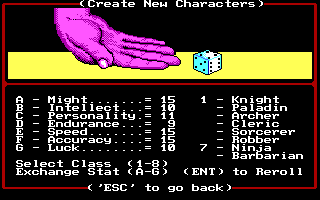
Much as the name suggest, the idea, at least for the original version, was that you party found a portal and manage to travel to another world, CRON, this hook as was the explantion from the why you could transfer a party from game to another (this was a common feature in old crpg). But what about the SNES and Genesis version? They don´t mention this at all, since well, you can´t really transfer character in this versions, but like the original, they play the same.
Another odd thing is that in the manual there was an entire part where Corak, explain the origin of CRON (remember how I explained that old crpg would have to expand their lore/background in creative ways to deal with storage and technical limtations?), but the way he explain is kind strange, since remember, CRON, much like VARN, is part of Ancient plan (and so part of spaceship). However, the way he describes, is most like a myth (the only explantion I have for why, is maybe because he is telling to a CRON natives habitants?), telling about the battles between the four elemental lords — Pyrannaste, Acwaladar, Gralkor and Shalwend, and how this battles created the world of CRON. He also explain, that several species, would emerge during this conflict (Humans, Elves, Dwarves, ect…) and how they would unite under king Kalohn to stop the elementals, using powerful artifacts know as the Talons (one for each element) and the Elemental Orb. Somehow this all happen inside a spaceship….
However, the elementals would return, and this time along with everyone favorite overpowered monster, the Mega Dragon. Kalohn would not survive since he no longer had the Talon (he used them to lock the elemental lords), but he manage to take the dragon with him.
While this all happens? Guess how show up! Sheltem! he manage to get Corak by surprise and separate his “soul” form his “body” at least that how the game mentions, but in reality, what Sheltem did as literal split Corak´s software from his hardware or throwing his HD away from his body… oh wait! I think I haven´t explained this — mostly because I have only vague memories when this is confirmed, because but both Corak and Sheltem, are some sort of androids or automatons.

As the game begins, you are visited by Corak “ghost”, telling you that “fantastic adventures wait you…” and nothing much else
While MM1 had the weight of time upon itself, MM2 is such improvement, that still highly playable — most crucial info is in the game, which even include in game hints and some sort of walktrough in form of codes which you need to decode. Also you now have an automap and even a minimap (in form of the spell Eagle Eye and Wizard Eye).
But that is not all, the game feature two news classes: Ninjas and Barbarians. Character can grow up to level 255 (this might be the height of the “MM power curve”) and do thing like 64 attacks per round! There is also for the first time the an “skill system” each character can have up to two skills, which can go from things like “Pathfinder” (which allow the party to walk in forests), “Crusader” (allow them to take quest from Kings), “Cartographer” (activate the automap), “Gladiator” (which give a bonus to Might).
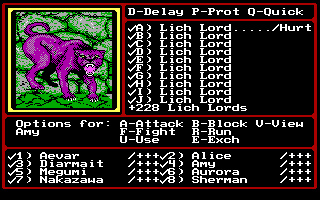
Another two major features are how the random treasure and random monster tables work. Battles in the game could be massive, reaching up to 255 monsters, and the game feature a huge list of them (I think that it also was something like 255 different monsters), but that´s not all. Instead of a single table, each map have his own table for monsters, and each monster had his own chance to generate treasures (some could give more money, other more magic items).
The treasures tables feature both unique items, such as Flaming Sword, Photon Blade, but more generic magic items, which much like in AD&D would have a “+” to item, except, that while in AD&D and magic item might to at best to +5, in MM2, with could go alway up to +64.

This two tables work in amazing way in the game, making combat kind fun, the massive table mean that encounter can feel but unique and challening at the same time, reinforcing a sense of risk and reward. However, it have to be said, that at late levels, very few thing could match you party, save some unique enemies, such as Time Lords, the Orc God or Devil Kings.
Another addition to the game was the hireling system, something which later games would expand, but the idea was that outside your six character, you could add two npcs to the party, this npcs would be spread around the world.
The plot is not imediatly clear, like I say, Corak only say some vague stuff, but as things unfold you kind have a bit of everything : time travel, a whole quest arc which is sort a “martial arts tournament arc”, robots, two resorts in conflict, phasers, one circus , more codes to dechyper than an Cold War spy and maybe the first instance in the MM universe of a upgrade quest for characters — the Juror´s Quest.
While the overall main quest of MM1 can feel confusing, MM2 main quest is pretty more clear — You need to revert the tragedy of King Kalohn, for this you need his daughter´s support, Queen Lamanda, something you can only get after winning the “Triple Crown” and making sure that each character in your party did they respective “Juror Quest” to win their “plus”.
Once you revert the past, which somehow does not cause any time travel related problems, King Kalohn send you to investigate the Square Lake Cavern, there you find, guess who? Sheltem, this time he is planning to throw CRON in the sun, to stop him you need to doone last puzzle/code, while Sheltem escapes (in the pc version you fight him, but in the other ones he escapes before the fight).
Since this game is still, like I said, high playable, I won´t extend here too much, but here is some highlights I which to talk about:
“Triple Crown”: This quest, requires you do visit arenas in each town, and here the game show a small mini game, at each two you have an arena and a ticket seller, each color of ticket mean a different difficult level for the fight. In case what you need is buying Black Ticket and using them in each arena.
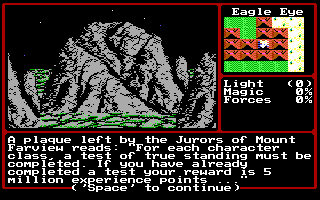
“Jurors Quest”: Overall this one, is a much improved version of the “Judgement Day” from MM1 and much more creative. The Jurors of Mount Farview, would require that each member of the party do a unique quest to win their puzzle. The catch is that not only the quest would be thematic for each class, but you need to split your party, and each quest was quite unique. This is the genesis of later games promotion quests.
Knights had to battle against the Dread Knight, Paladins need to invade a dungeon and kill the Frost Dragon, Ninjas had to go to Dawn´s Mystic Cave and kill her. But more important, remember Corak? The cleric quest was about finding his “soul” and unite with it his “body”. Also, worth of note, Robbers didn´t have their own quest, instead they could follow any character in their quest and win their plus in this way.
Time Travel: As I mentioned, you might be curios of how this happen and it was fairly simple, one of the local lords, Peabody, sort taking advantage of Corak begin defeated, simple stole the machine from Corak´s room (I guess he called dibs on the machine soon as he found that Corak went missing). Time Travel in the game, once unlocked by finishing a quest for Peabody, was only used for two quests, but somehow you could travel to at least eight different time period, but there was nothing do to there (I mean the world was empty).
Circus: One the 140 day, each year the Circus would show up, doing some minor quests for them you could raise your stats to 100.
Murray´s Resort Island and Dawn´s Mystic Bog: Come to think about, MM2 sort had his own thermal/resort/beach episode…ok, talking serious, the deal is that Murray want some help dealing with Dawn competition.
Remember how I said characters could become ridiculous powerful?


Some other classic MM 2 moments: The Ancient Dragon was one of the game unique encounters that sort acted as extra turning point, since between the massive experience and treasure, along with other treasure around him would speed your party a lot. The Cuisinart was another one, this one was trick, in one hand, they would use a special Frenzy attack which would do massive damage but would kill them in the process, if you manage to survive it there was some truly massive experience to be earned.


Nature of the World — Part I
Before we proceed to MM3 to MM5, I think I need to talk about how the world look like in the previous games and how would look like in the next games.
In MM1 to MM2, the game was a first person grid based crpg, so imagine and grid sheet in a certain size (15 x 15) you then draw walls and rooms on it, you will quickly notice, that despite it small size, you can cram a lot of stuff there, even more that maybe you could do in full 3D, with one advantage:
Despite you fill the whole, let´s say - 15x15 grid map - with rooms, corridos and etc… it still just a small map, that does not take that much time to proper explore it. This is the main advange of the grid, unless you go over board and the size is simple too large, things feel big, but small.
However, like I said, if maps are too big, let´s say like in some of the Legend of Ishar games, this advantage is lost, and exploring becoming tedious and depending on the engine, can create a line of sight issue, specially in open spaces. As exemple, there is one map in MM1 where, due the graphics begin almos a wireframe and the place begin an ocean space, so without any walls, you could get really lost.
But there is one more important element, to keep in mind, that the representation of space is this mode is sort abastract not literal, in MM 1 and MM 2 a square could fit between a single and 255 monsters, or a npc (which maybe a single person or whole shop/tavern/temple) and so on.

This specially true when you move outside dungeons and goes to either overworld or other space (but not an interior), a map of the same size of 15 x 15 (I am using MM2 map size for this examples), is used both let´s say to map a town like Middle Gate or overworld part or the dungeon under Middle Gate.
Now the trick thing is that while you agree a single square in interior space is around around a certain size, but what about that overworld? There the city is represented by a single square. The point is that space in sort abstracted.
There is limitations of course, one is that how you represent height? In classic grid base (and mean the older ones), you can´t really represent a two floor building visually most of the time (but you still be able to climb to a second floor). However, some games find trick around to represent height — In Ishar 2 they used some cleaver image tricks to give you the illusion that you are climbing a mountain or while in city.


But let´s go back to MM 1–2, like I said, the game would have maps for dungeons, cities and other places suchs as castles, connecting them, you have an “over world map”, which in essence are 5x4 maps side by side (split in A, B, C, D, E and numbers from 1 to 4), Middle Gate (MM2 starting town), was in C2, while Atlantida was in A4. Encounters would happen in a single square (which could be either random or fixed) and like I said, it could fit between one and too many enemies at once.
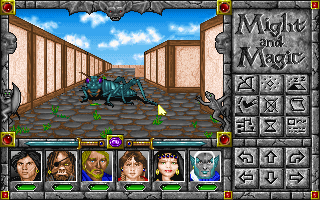
In the next three games (MM 3-5) , not much changes, except one major element, now monsters wander around the map and only a certain number of them could fit a single square. You can move around them and attack them at distance, now position sure matter a lot more as you can get surrounded. But you could easily disengage and run if necessary.
Ok, with this whole thing done, let´s cover the next three games.
From Three to Five:
More than before, this three games, still high playable and I really recommend, so much that from this point on, I sort try avoid spoilers and stay close only to what I think I need to say.
During this moment, the series gain proably, it fastest pace, so much that here you almost don´t have that “survival phase”, things speed up really quickly. Add to this that monsters now wander across the map and your party can hit them with ranged attacks or spell for afar, and while there isn´t so many enemies at once like in previous games, all combine for a very dinamic pace. While characters don´t do that much of attacks per round, you still can do a lot more than usual, as each class gain extra attack on certain levels (Barbarians gain one more for each four levels, Knight gain one for each five levels, and so on).
One major difference, it that the game now hide the “dice rolls” and other info during combat, instead it just show a blood spat of difference size to reflect damage, enemies names would change colors to reflect how much damage they have taken (such as yellow for half, red for almost dying). This does not mean the game removed the numbers, what they did is just hide them, but you still have spells to show how much hp an enemy had or you could look the description of weapons and see the damage. This change is sort ok, even if at times, by hidding info it sort make difficult to know what going on, however, this games are far from hard, so this isn´t much a issue.
Might and Magic III - Isles of Terra

With MM4 and MM5 standing out the way they do, this one is somewhat easy to forget — however, MM 3 does fill a very important part on the overall MM plot and was the first implementation of a whole new engine, which would be used for MM4 and MM5. Not only this, this game is maybe when MM series a whole, start to reach is own peak in terms of visual identidy, since until that point, most graphics have been very simple, now you have more detailed visual and sprites and this are quite unique, so much that is kind hard to pin point, what exactly the game was trying to do.
Character design might go from a comic (maybe even slight anime, it hard to pin down) style to a cartoonish style to a “slight realistic” (I mean remember the archer sprite in Clouds of Xeen?). Building, cities, dungeons do the same. Music was also in their highest peak too and the game would feature digitalized voices. All this element sort make this three games the most unique in the franchise.
In MM3, both in the manual and ingame, we learn more about what exactly the Ancients where up too and is their deal — the so called “Grand Experiment”.
I will try to explain it, since is kind crucial, but it confusing and I might get stuff wrong. Again, I really recommend playing the game.
In the manual, we have Corak again telling us about this new world, in much the same way he describe CRON, with elemental lords fighting for the control of the “Void” with lands emerging from the battle, along with species, eventually they where defeated with the help of the “Forces of the Dome”. This “forces” would then take this “lands” to TERRA. I think, this is what the game later call the “Elemental Manipulation”.
So what about CRON and VARN? turn they are microcosmos created by the Ancients, to be delivered to TERRA (or other place) as a new continent and so they (the Ancients) where literally “seeding” planets. So yeah, CRON and VARN, like I said are spaceships begin on route to TERRA.
Each planet and VARN (the game calls CRON and VARN as a “VARN”) had his own guardian, TERRA had Sheltem, CRON had Pegasus and later we will meet the Pharoh Dragon of XEEN.
But back to Sheltem, he was the guardian and the “Supreme Law” of TERRA and things go off rails when the new VARN (or something else) arrive his planet, and you see… Sheltem never truly saw himself as an agent of the Ancients, he, at least under his eyes, saw himself as TERRA surpreme ruler and didn´t like that and soon start to rebel (in sort there was a internal conflict between begin an agent and the protect TERRA protocols).
Ancients figured out the problem and created another agent, Corak to stop him, and at the beggining thing went smooth, Corak captured Sheltem and take him away from TERRA. However, Sheltem escapes and runs to VARN where he becomes the False King Alamar in MM1, after begin defeated he flees again, this time to CRON (MM2), but again he fails and flee, but this time he returns to TERRA, where he upset the balance of the “Force of Dome” there. Much of the plot is about help one of the Kings which represent an aspect of the force.

MM3 also introduced ability to choose protraits for your character and this would be sort animated changing to reflect different status. Outside this, not much change in character creation, except three things — one is the addition of Druids and Rangers, the both are able to cast spell from both Sorceror and Cleric lists. Skills also changed, each character can now learn unlimited number of skills. Also you can again add Hireling to your party.
Now, instead of starting direct in the character creation, the game sort drop you with a pre ready party, and for a while you might be confused of how or when you create a party, but what you have to do is start the game, go to the nearby inn and there remove the premade party to them create a new one.
Talking about this premade party, let´s describe the whole group a bit, you have:
- Sir Canegm (Human, Paladin, Good),
- Crag Hack (Dwarf, Barbarian, Neutral),
- Maximus (Half-Orc, Knight, Evil),
- Dark Shade (Gnome, Robber, Evil),
- Resurrectra (Gnome, Cleric, Good),
- Kastore (Elf, Sorceror, Neutral).
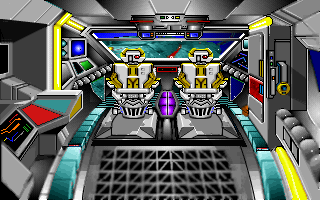
They are quite important, following the canon, once you help one of the kings and do some other quests, you go after Sheltem, only to find him fighting against Corak, again he manage to escape using a spaceship, with Corak following hot on his track in another spaceship. Your party them pick up a third space ship and tries to follow them.
Might and Magic IV (World of Xeen) - Clouds of Xeen

If I had to suggest one MM game suggest to someone, I would with doubt, recommend MM 4–5, or how is mostly know — World of Xeen. You see, originally, MM4 and MM5 where sort separated games, but they together, from a single game.
XEEN, is another VARN, but as is destinity isn´t fullfilled, it still in its “flat” format (remember it still part of spaceship!), the first game MM4 — Clouds of Xeen happen in the upper part of XEEN, while MM5 — Darkside of Xeen, happen in the lower part.
Sheltem escaped to XEEN, where he first take of the Darkside and them hatched a plan to take over the Cloudside. This stop this plan is the plot of MM4: King Burlock of the Cloudside send his brother Roland to the Darkside in a mission, however, Roland goes missing and suddenly reappear.
Roland convinces Burlock goes in futily quest for the Sixth Mirror, the court wizard, Crodo, tries to stop Burlock but in attempt to confront Roland, by accident, discover that this isn´t the real Roland, but the self proclamed Lord Xeen an Lich acting as a lieutenant for Sheltem. Xeen captures Crodo and lock in a tower while taking time to kill a group of adventures which where trying to make a magic weapon to kill him, destroying New Castle in the process.
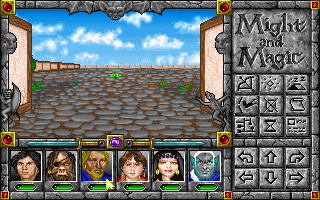
The game start with Crodo asking for your help, and it up to you to find someway to free him, restore New Castle, take the Xeen Slayer Sword and stop Lord Xeen.
The game character creation didn´t change at all, as the game uses the same engine, which have slight more polished graphics. Also present, is digitalized voices for npcs.
Now what does change, is that there is great emphasis in heigh for the world, meaning that towns, castles, towers now can have several floor, which often lead to the “Cloud World”, which act as a secundary over world the game.
It also feature, for the first time in the MM games, the concept of taking over an castle and rebuilding it, something which we see again in MM7. In MM4 you would collect “King Mega Credits” and use them to rebuild New Castle, until you can acess the place where the Xeen Slayer Sword is.
Once you confront Lord Xeen in his castle, you find out that he was just a lieutenant for Sheltem. Burlock them send you for the Darkside.



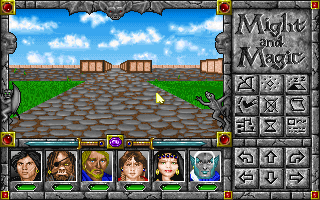
Might and Magic V (World of Xeen) - Darkside of Xeen

Following the manual, reading the Pharaoh Dragon logs, we learn that Xeen as whole was preparting for a massive ceremony, which would require the cooperation of both sides and that was the reason Roland was send to the Darkside. However, an misterious figure calling himself Alamar, soon throw everything to dust. As you might guess, this Alamar is in fact, Sheltem (I love how he simple used the same name), he captured Queen Kalindra and with the help of Count Black Fang turned her in a vampire. Also he besieged the Paraoh Dragon castle, while taking over the Darkside.
As your party travel to the Darkside, they have to rescue and restore Kalindra and confront Sheltem for one last time. In this game, is where we learn a lot of the backstory of the series, finding out how Sheltem got in Xeen first, but when Corak tried to land the got stuck in his ship. What about the adventures? Sheltem believe they are destroyed, but what happened is something we learn much later. This is also the game where the whole Corak and Sheltem arc sort ends, but I won´t spoil it.
Once things where solved, the final quest is unlocked, remember the ceremony? and about Xeen destiny? Here is the deal, Xeen must become a full spherical world, but do to this one final quest for this, which would involve travelling between both sides of the world.
While the game is sort the same, music and graphics where a lot better and visual had a more darker tone.
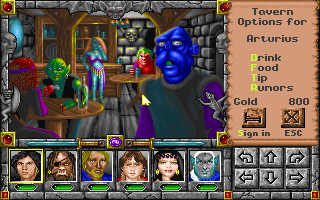



On the Next episode
We shall move to the 3DO era, covering MM 6-9, this is likely a smaller article and like I said, save a few screenshots of MM6, which I had saved on Photobucket, there might not be many images (I mostly like play MM7-8 just to take a few screenshots, like I did now with Xeen).
Links for All the Parts:
Part One: Might and Magic X — An Fitting End? Part One
Part Two: Might and Magic X — An Fitting End? Part Two - The Early Games
Part Three: Might and Magic X — An Fitting End? Part Three - The 3DO Era
Part Four: Might and Magic X - The End (Part 4)
